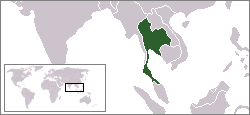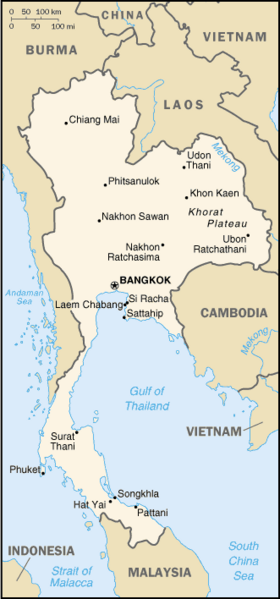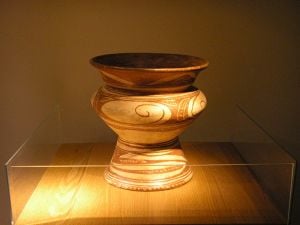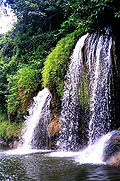Thailand
| ราชอาณาจักรไทย Ratcha Anachak Thai Kingdom of Thailand | |||||
| |||||
| Anthem: Phleng Chat Royal anthem: Phleng Sansoen Phra Barami | |||||
| Capital | Bangkok (Krung Thep) 13°44′N 100°30′E | ||||
|---|---|---|---|---|---|
| Largest city | Bangkok | ||||
| Official languages | Thai | ||||
| Government | Military junta under Constitutional Monarchy | ||||
| - King | HM The King Bhumibol Adulyadej | ||||
| - Prime Minister | General Surayud Chulanont | ||||
| - President of the Council of National Security | General Sonthi Boonyaratglin | ||||
| Independence | |||||
| - Sukhothai kingdom | 1238–1368 | ||||
| - Ayutthaya kingdom | 1350–1767 | ||||
| - Thonburi kingdom | 1767 to April 7 1782 | ||||
| - Ratanakosin kingdom | April 7 1782 to date | ||||
| Area | |||||
| - Total | 514,000 km² (49th) 198,000 sq mi | ||||
| - Water (%) | 0.4 | ||||
| Population | |||||
| - July 2006 estimate | 64,631, 5951 | ||||
| - 2000 census | 60,916,441 | ||||
| - Density | 126/km² /sq mi | ||||
| GDP (PPP) | 2005 estimate | ||||
| - Total | $560.7 billion | ||||
| - Per capita | $8,300 | ||||
| HDI (2004) | 0.784 (medium) | ||||
| Currency | Baht (฿) (THB)
| ||||
| Internet TLD | .th | ||||
| Calling code | +66 | ||||
| 1 Estimates for this country explicitly take into account the effects of excess mortality due to AIDS; this can result in lower life expectancy, higher infant mortality and death rates, lower population and growth rates, and changes in the distribution of population by age and sex than would otherwise be expected. 2 Based on July 2005 figures. | |||||
The Kingdom of Thailand lies in Southeast Asia, with Laos and Cambodia to its east, the Gulf of Thailand and Malaysia to its south, and the Andaman Sea and Myanmar to its west.
The country's official name was Siam until June, 1939. The word Thai (ไทย) means "freedom" in the Thai language and is also the name of the majority ethnic group.
Geography
At 198,000 square miles), (513,000 square kilometers) Thailand is the world's 49th-largest country. It is comparable in size to Spain, and somewhat larger than the US state of California. Thailand is home to several distinct geographic regions, partly corresponding to the provincial groups.
The north of the country is mountainous, with the highest point being Doi Inthanon at 8451 feet (2576 meters). During the winter months in the north, the temperature is cool enough for the cultivation of fruits such as lychees and strawberries. Steep river valleys cut into these high mountains and upland areas that border the central plain.
The northeast consists of the dry Khorat Plateau, bordered to the east by the Mekong river. The soils are poor, and the short monsoon season brings heavy flooding in the river valleys. Sparse grasses cover much of the land.
The centre of the country is dominated by the predominantly flat Chao Phraya river valley, which runs into the Gulf of Thailand. The "heartland", Central Thailand, is a natural self-contained basin often termed "the rice bowl of Asia." The complex irrigation system developed for wet-rice agriculture in this region provided the necessary economic support to sustain the development of the Thai state from the thirteenth century, the Sukhothai kingdom, to contemporary Bangkok.
The south consists of the narrow Kra Isthmus that widens into the Malay Peninsula. The South is distinctive in climate, terrain, and resources. Its economy is based on rice cultivation for subsistence and rubber production for industry. Other sources of income include coconut plantations, tin mining, and tourism, which is particularly lucrative on Phuket Island.
The climate is tropical and characterised by monsoons. There is a rainy, warm, and cloudy southwest monsoon from mid-May to September, as well as a dry, cool northeast monsoon from November to mid-March. The southern isthmus is always hot and humid. Temperatures normally range from an average annual high of 100 °F (38 °C) to a low of 66 °F (19 °C).
Natural resources include: tin, rubber, natural gas, tungsten, tantalum, timber, lead, fish, gypsum, lignite, fluorite and arable land.
Environmental concerns include land subsidence in the Bangkok area resulting from the depletion of the water table, droughts and earthquakes. Current environmental issue include: air pollution from vehicle emissions, water pollution from organic and factory wastes, deforestation, and soil erosion. Wildlife populations are threatened by illegal hunting.
Major cities beside the capital Bangkok include Nakhon Ratchasima, Khon Kaen, Udon Thani, Nakhon Sawan, Chiang Mai, Surat Thani, Phuket and Hat Yai.
History
Due to its geographical location, Thai culture has always been greatly influenced by China and India. However, different indigenous cultures have also existed in Thailand since the Ban Chiang culture, which dates back to 2100 B.C.E.
Ban Chiang is an archaeological site located in the Nong Han district, of the Udon Thani Province that was discovered in 1957. The oldest graves found contain no bronze and are therefore from a Neolithic culture; the latest ones are from the Iron Age. The earliest grave was about 2100 B.C.E. and the latest about 200 C.E.
The first Siamese/Thai state is traditionally considered the Buddhist kingdom Sukhothai. According to tradition, Thai chieftains gained independence from the Khmer Empire at Sukhothai, which was established as a sovereign Kingdom by Pho Khun Si Indrathit in 1238.
The northern state of Lanna coexisted with Sukhothai. This state emerged in the same period as Sukhothai, but survived longer, ending in 1558, when it fell to the Burmese. Thereafter it was dominated by Burma and Ayutthaya in turn before falling to the army of the Siamese King Taksin in 1775.
The larger Siamese kingdom of Ayutthaya, established in the mid-fourteenth century, overshadowed Sukhothai's power. After Ayutthaya sacked Angkor in 1431, much of the Khmer court and its Hindu customs were brought to Ayuthaya, and Khmer customs and rituals were adopted into the courtly culture of Siam. The first ruler of the Kingdom of Ayutthaya, King Ramathibodi I, established Theravada Buddhism as the official religion and compiled of the Dharmashastra, a legal code based on Hindu sources and traditional Thai custom.
After more than 400 years of power, in 1767, invading Burmese armies brought down the Kingdom of Ayutthaya, burned its capital burned, and split the territory split. Thonburi was the capital of Thailand for a brief period under King Taksin the Great, until a coup d'etat in 1782. The current (Ratthanakosin) era of Thai history began in 1782 following the establishment of Bangkok as capital of the Chakri dynasty under King Rama I the Great.
European powers began travelling to Thailand in the sisteenth century. Despite European pressure, Thailand is the only Southeast Asian country to have never been colonized by a European power. The reasons for this are that Thailand had a long succession of able rulers in the 1800s and that it was able to utilise the rivalry and tension between the French and the British. As a result, the country remained as a buffer state between parts of Southeast Asia that were colonised by the two colonial powers. Despite this, Western influence led to many reforms in the nineteenth century and major concessions to British trading interests. This included the loss of the three southern provinces, which later became Malaysia's three northern states. The Anglo-Siamese Treaty of 1909 made the modern border between Siam and British Malaya,
The Siamese coup d'état of 1932 transformed the Government of Thailand from an absolute to a constitutional monarchy. King Prajadhipok initially accepted this change but later surrendered the throne to his ten-year old nephew, Ananda Mahidol.
In early January 1941, Thailand invaded French Indochina, beginning the French-Thai War. The Thais were better equipped than, and outnumbered, the French forces, easily taking Laos. The French decisively won the naval Battle of Koh Chang. The Japanese mediated the conflict. On May 9 a peace treaty was signed in Tokyo, with the French being coerced by the Japanese into relinquishing its hold on the disputed territories.
On December 8, 1941, a few hours after the attack on Pearl Harbor, Japan demanded the right to move troops across Thailand to the Malayan frontier. Japan invaded the country and engaged the Thai army for six to eight hours. Japan was granted free passage, and on December 21, 1941, Thailand and Japan signed a military alliance with a secret protocol wherein Tokyo agreed to help Thailand get back territories lost to the British and French colonial powers and Thailand undertook to assist Japan in her war against the Allies.
After Japan's defeat in 1945, with the help of a group of Thais known as Free Thai Movement who were supported by the United States, Thailand was treated as a defeated country by the British and French, although American support mitigated the Allied terms. Thailand was forced to return the territory it had gained to the British and the French. In the post-war period Thailand enjoyed close relations with the United States, which it saw as a protector from the communist revolutions in neighbouring countries.
King Ananda Mahidol (Rama VIII) died in 1946 under somewhat mysterious circumstances, the official explanation being that he shot himself by accident while cleaning his gun. His brother Bhumibol Adulyadej succeeded him to become the longest reigning king of Thailand, and very popular with the Thais.
Although nominally a constitutional monarchy, Thailand was ruled by a series of military governments, most prominently led by Luang Phibunsongkhram and Sarit Dhanarajata, interspersed with brief periods of democracy.
In 1997, the Asian financial crisis hit Thailand and the Thai baht was soon worth 56 baht to the US Dollar compared to about 25 baht to the dollar before 1997. Since then the baht has regained some strength and currently trades around 36-38 baht to the dollar.
In 1992 the last military ruler, Suchinda Kraprayoon, gave up power in the face of massive popular protests, supported by the king. From 1992 to September 2006, Thailand was a functioning democracy with constitutional changes of government.
On September 19, 2006, the Royal Thai Army led by Army Commander General Sonthi Boonyaratglin seized control of government when billionaire Prime Minister Thaksin Shinawatra was in New York at the United Nations General Assembly. Later, the military declared martial law, abrogated the Thai Constitution, and suspended Parliament. A new Prime Minister was sworn in on 1 October, 2006, and Thailand's king swore in a post-coup cabinet, chosen by new Prime Minister General Surayud Chulanont.
The Thai solar calendar is based on Eastern version of the Buddhist Era, which is 543 years ahead of the Gregorian (western) calendar. For example, the year AD 2007 is called 2550 BE in Thailand.
Government and politics
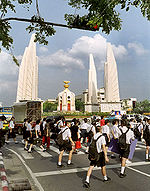
Thailand was a representative democratic constitutional monarchy until the sudden coup on September 19, 2006. The Thai public, however, appear to be largely unaffected by this reform, as the change is constitutional, not physical.
The king has little direct power under the constitution. However, as a king, he is a sign of national identity and is the chosen protector of Buddhism in Thailand. The present monarch enjoys a great deal of popular respect and moral authority, which has on occasion been used to resolve political crises. It is considered a crime to mock or criticize the King and in doing, one can expect charges of lese majesty.
Under the pre-coup democracy, the head of government was the Prime Minister, and is appointed by the king from among the members of the lower house of parliament, usually the leader of the party that can organise a majority coalition government. The Prime Minister usually appoints a Cabinet.
The parliament was called the National Assembly and was bicameral: it consisted of a house of representatives of 500 seats and a senate of 200 seats. Members of both houses were elected by popular vote. The senate was elected based on the province system, where one province can return more than one Senator depending on its population size. Members of the house of representatives served four-year terms, while senators served six-year terms.
The court system has three layers, the highest body being the Supreme Court.
Thailand is an active member of the regional Association of Southeast Asian Nations.
Thailand is divided into 76 provinces, which are gathered into five groups of provinces by location. There are also two special governed districts: the capital Bangkok and Pattaya, of which Bangkok is also at a provincial level, while Pattaya is part of Chon Buri Province. Some Thai people still count Bangkok as a province, making Thailand a 76-province country.
Each province is divided into smaller districts. As of 2000 there are 796 districts, 81 minor districts, and the 50 districts of Bangkok.
Economy
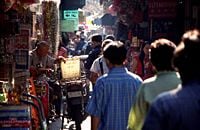
After enjoying the world's highest growth rate from 1985 to 1995 - averaging almost 9% annually - increased pressure on Thailand's currency, the baht, in 1997 led to a crisis that uncovered financial sector weaknesses and forced the government to float the currency. Long pegged at 25 to the US dollar, the baht reached its lowest point of 56 to the US dollar in January 1998 and the economy contracted by 10.2% that same year. The collapse prompted a wider Asian financial crisis.
Thailand entered a recovery stage in 1998, expanding 4.2% and grew 4.4% in 2000, largely due to strong exports - which increased about 20% in 2000. Growth was dampened by a softening of the global economy in 2001, but picked up in the subsequent years due to strong growth in China and the various domestic stimulation programs of Prime Minister Thaksin Shinawatra, popularly known as Thaksinomics. Growth in 2003 and 2004 was over 6% annually.[1]
Thailand exports over $105 billion worth of products annually [1]. Major exports include rice, textiles and footwear, fishery products, rubber, jewelry, automobiles, computers and electrical appliances. Thailand is the world’s no.1 exporter of rice, exporting 6.5 million tons of milled rice annually. Rice is the most important crop in the country. Thailand has the highest percent of arable land, 27.25%, of any nation in the Greater Mekong Subregion [2]. About 55% of the available land area is used for rice production [3].
Substantial industries include electric appliances, components, computer parts and automobiles, while tourism contributes about 5% of the Thai economy's GDP. Long stay foreign residents also contribute heavily to GDP.
The main natural resources of Thailand are tin, rubber, natural gas, tungsten, tantalum, timber, lead, fish, gypsum, lignite, fluorite, and arable land.
Demographics
Thailand's population is dominated by various Tai-speaking peoples. Among these, the most numerous are the Central Thai, the Northeastern Thai or Isan or Lao, the Northern Thai, and the Southern Thai. The Central Thai have long dominated the nation politically, economically, and culturally, even though they make up only about one-third of Thailand's population and are slightly outnumbered by the Northeastern Thai. Due to education system and the forging of a national identity, many people are now able to speak Central Thai as well as their own local dialects.
The largest group of non-Tai people are the Chinese who have historically played a disproportionately significant role in the economy. Most have integrated completely into mainstream Thai society, and do not live in Bangkok's Chinatown on Yaowarat Road. Other ethnic groups include Malays in the south, Mon, Khmer and various hill tribes. After the end of the Vietnam War, many Vietnamese refugees settled in Thailand, mainly in the northeastern regions.
According to the last census (2000) 94.6% of Thais are Buddhists of the Theravada tradition. Muslims are the second largest religious group in Thailand at 4.6%. Some provinces and towns south of Chumphon have dominant Muslim populations, including many ethnic Thai.[verification needed] Often Muslims live in separate communities from non-Muslims. The southern tip of Thailand are mostly ethnic Malays and they are mostly concentrated in the south, where they form a strong majority in four provinces. Christians, mainly Catholics, represent 0.75% of the population. A tiny but influential community of Sikhs and some Hindus also live in the country's cities.
The Thai language is Thailand's national language, written in its own alphabet, but many ethnic and regional dialects exist as well as areas where people speak predominantly Isan or Mon-Khmer languages. Although English is widely taught in schools, proficiency is low.
Culture
Theravada Buddhism is central to modern Thai identity and belief, though in practice it has evolved over time to include many regional beliefs originating from animism as well as ancestor worship. In areas in the southernmost parts of Thailand, Islam is prevalent. Several different ethnic groups, many of which are marginalized, populate Thailand. Some of these groups overlap into Myanmar, Laos, Cambodia, and Malaysia and have maintained a distinctly traditional way-of-life despite strong Thai cultural influence. Ethnic Chinese also form a significant part of Thai society, particularly in and around Bangkok. Their successful integration into Thai society has allowed for this group to hold positions of economic and political power, the most noteworthy of these being the Thai Prime Minister, Thaksin Shinawatra, who held power from 2001 until September 19, 2006 when he was ousted by a military coup d'état.
Like most Asian cultures, respect towards ancestors is an essential part of Thai spiritual practice. Thais have a strong sense of hospitality and generousity, but also a strong sense of social hierarchy. Seniority is a important concept in Thai culture. Thais will bow to their feet of their parents or grandparents to honor them. In addition, the elders always rule in family decisions or ceremonies.
Muay Thai, or Thai boxing, is the national sport in Thailand and its native martial art. It reached popularity all over the world in the 1990s. Although similar martial art styles exist in other southeast Asian countries, few enjoy the recognition that Muay Thai has received with its full-contact rules allowing strikes including elbows, throws and knees. Association football, however, has possibly overtaken Muay Thai's position as most widely viewed and liked sport in contemporary Thai society and it is not uncommon to see Thais cheering their favourite English Premier League teams on television and walking round in replica kits. Another widely enjoyed pastime, while not a sport per se, is kite flying.
The standard greeting in Thailand is a prayer-like gesture called the wai (see namaste). Taboos include touching someone's head or pointing with the feet, as the head is considered the most sacred and the foot the dirtiest part of the body. Stepping over someone, or over food, is considered insulting. However, Thai culture as in many other Asian cultures, is succumbing to the influence of westernization and some of the traditional taboos are slowly fading away with time.
Books and other documents are the most revered of secular objects - therefore one should not slide a book across a table or place it on the floor.
Thai cuisine blends five fundamental tastes: sweet, spicy, sour, bitter and salty. Some common ingredients used in Thai cuisine include garlic, chillies, lime juice, lemon grass, and fish sauce. The staple food in Thailand is rice, particularly jasmine variety rice (also known as Hom Mali rice) which is included in almost every meal. Thailand is the world's largest exporter of rice and Thais domestically consume over 100 kg of milled rice per person per year [3]. Clearly, rice is an important part of Thai culture. Over 5000 varieties of rice from Thailand are preserved in the rice gene bank of the International Rice Research Institute (IRRI), based in the Philippines. The King of Thailand is the official patron of IRRI[4].
Thai culture has been greatly shaped in recent years by its vibrant and free press. There are numerous English, Thai and Chinese papers in circulation and Thailand is the largest newspaper market in South East Asia with an estimated circulation of at least 13 million copies daily in 2003.
International rankings
| Organisation | Survey | Ranking |
|---|---|---|
| Heritage Foundation/The Wall Street Journal | Index of Economic Freedom | 71 out of 157 |
| The Economist | Worldwide quality-of-life index, 2005 | 42 out of 111 |
| Reporters Without Borders | Worldwide press freedom index | 122 out of 167 |
| Transparency International | Corruption Perceptions Index | 63 out of 163 |
| United Nations Development Programme | Human Development Index | 72 out of 177 |
See also
Template:Portal:Thailand/box-header Template:Portal:Thailand topics Template:Portal:Thailand/box-footer
Notes
- ↑ 1.0 1.1 CIA world factbook - Thailand Cite error: Invalid
<ref>tag; name "CIA_Thailand" defined multiple times with different content - ↑ CIA world factbook - Greater Mekong Subregion
- ↑ 3.0 3.1 IRRI country profile Cite error: Invalid
<ref>tag; name "IRRI_Thailand" defined multiple times with different content - ↑ Cooperation of IRRI and Thailand
External links
Official
- Thaigov.go.th Royal Government of Thailand
- Tourism Authority of Thailand Official tourism website
- Thai National Assembly Official Thai Parliament website
- Mfa.go.th Thailand Ministry of Foreign Affairs
- Thailand Internet Information Thailand : National Electronics and Computer Technology Center
Other
- CIA - The World Factbook - Thailand
- Template:Flickr
- Thailand Travel Dictionary Non-commercial information site
Brunei · Cambodia · Christmas Island (Australia) · Cocos (Keeling) Islands (Australia) · East Timor · Indonesia · Laos · Malaysia · Myanmar · Philippines · Singapore · Thailand · Vietnam
Template:Andaman Sea
![]() Brunei •
Brunei • ![]() Cambodia •
Cambodia • ![]() People's Republic of China •
People's Republic of China • ![]() Republic of China (Taiwan) (Taiwan) •
Republic of China (Taiwan) (Taiwan) • ![]() Hong Kong(PRC) •
Hong Kong(PRC) • ![]() Indonesia •
Indonesia • ![]() Macau(PRC) •
Macau(PRC) • ![]() Malaysia •
Malaysia • ![]() Philippines •
Philippines • ![]() Singapore •
Singapore • ![]() Thailand •
Thailand • ![]() Vietnam
Vietnam
Template:Indian Ocean Template:ASEAN
| Member states and observers of the Organization of the Islamic Conference (OIC) | |||||||
|---|---|---|---|---|---|---|---|
| Members |
| ||||||
| Observers |
| ||||||
| Monarchies | |
|---|---|
| African | |
| Asian | |
| Commonwealth Realms | |
| European | Andorra · Belgium · Denmark · †Liechtenstein · Luxembourg · †Monaco · Netherlands · Norway · Spain · Sweden · Vatican City (Holy See) |
Credits
New World Encyclopedia writers and editors rewrote and completed the Wikipedia article in accordance with New World Encyclopedia standards. This article abides by terms of the Creative Commons CC-by-sa 3.0 License (CC-by-sa), which may be used and disseminated with proper attribution. Credit is due under the terms of this license that can reference both the New World Encyclopedia contributors and the selfless volunteer contributors of the Wikimedia Foundation. To cite this article click here for a list of acceptable citing formats.The history of earlier contributions by wikipedians is accessible to researchers here:
The history of this article since it was imported to New World Encyclopedia:
Note: Some restrictions may apply to use of individual images which are separately licensed.


